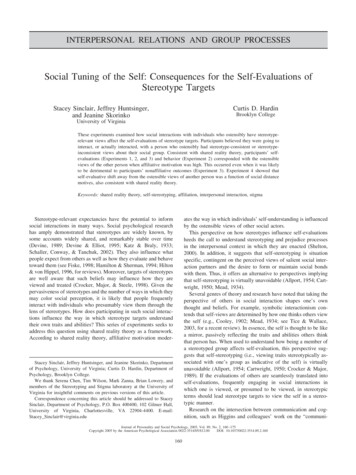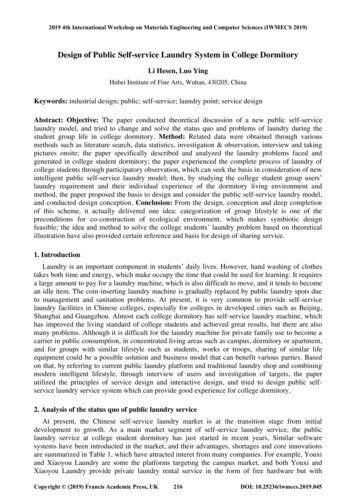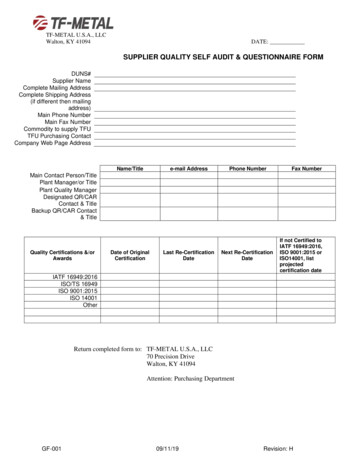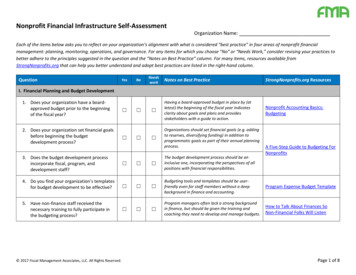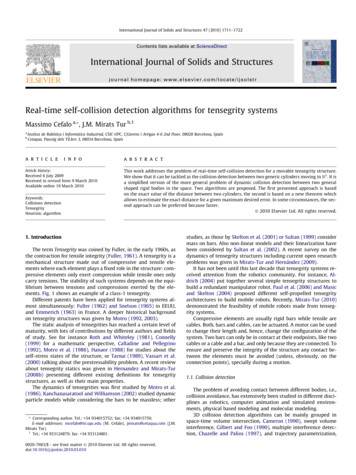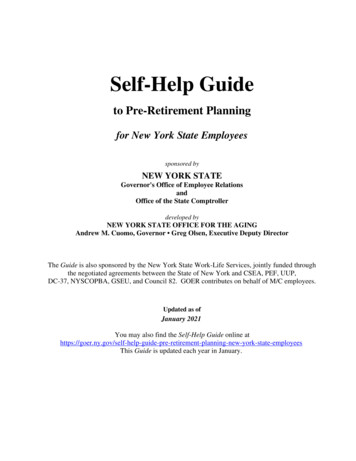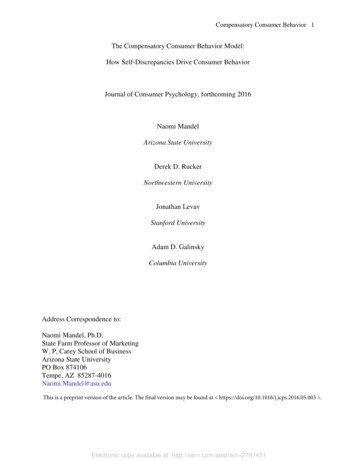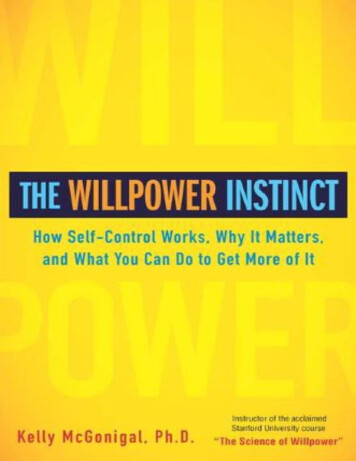
Transcription
Table of ContentsTitle PageCopyright PageDedicationEpigraphIntroductionONE - I Will, I Won’t, I Want: What Willpower Is, and Why It MattersTWO - The Willpower Instinct: Your Body Was Born to Resist CheesecakeTHREE - Too Tired to Resist: Why Self-Control Is Like a MuscleFOUR - License to Sin: Why Being Good Gives Us Permission to Be BadFIVE - The Brain’s Big Lie: Why We Mistake Wanting for HappinessSIX - What the Hell: How Feeling Bad Leads to Giving InSEVEN - Putting the Future on Sale: The Economics of Instant GratificationEIGHT - Infected! Why Willpower Is ContagiousNINE - Don’t Read This Chapter: The Limits of “I Won’t” PowerTEN - Final ThoughtsAcknowledgementsNOTESINDEX
Published by the Penguin GroupPenguin Group (USA) Inc., 375 Hudson Street, New York, New York 10014, USA Penguin Group(Canada), 90 Eglinton Avenue East, Suite 700, Toronto, Ontario M4P 2Y3, Canada (a divisionof Pearson Penguin Canada Inc.) Penguin Books Ltd, 80 Strand, London WC2R 0RL,England Penguin Ireland, 25 St Stephen’s Green, Dublin 2, Ireland (a division of PenguinBooks Ltd) Penguin Group (Australia), 250 Camberwell Road, Camberwell, Victoria 3124,Australia (a division of Pearson Australia Group Pty Ltd) Penguin Books India Pvt Ltd,11 Community Centre, Panchsheel Park, New Delhi–110 017, India Penguin Group (NZ),67 Apollo Drive, Rosedale, North Shore 0632, New Zealand (a division ofPearson New Zealand Ltd) Penguin Books (South Africa) (Pty) Ltd,24 Sturdee Avenue, Rosebank, Johannesburg 2196, South AfricaPenguin Books Ltd, Registered Offices: 80 Strand, London WC2R 0RL, EnglandCopyright 2012 by Kelly McGonigal, Ph.D.All rights reserved. No part of this book may be reproduced, scanned, or distributed in anyprinted or electronic form without permission. Please do not participate in or encourage piracyof copyrighted materials in violation of the author’s rights. Purchase only authorized editions.Published simultaneously in CanadaBrain illustrations by Tina Pavlatos, Visual Anatomy Limited“Current Self v. Future Self” scale courtesy Hal Ersner-Hershfield and Jon BaronMost Avery books are available at special quantity discounts for bulk purchase for sales promotions, premiums, fund-raising, andeducational needs. Special books or book excerpts also can be created to fit specific needs. For details, write Penguin Group (USA) Inc.Special Markets, 375 Hudson Street, New York, NY 10014.Library of Congress Cataloging-in-Publication DataMcGonigal, Kelly.The willpower instinct : how self-control works, why it matters, and what you can do toget more of it / Kelly McGonigal.p. cm.ISBN : 978-1-101-55373-21. Will. 2. Self-control. I. Title.BF632.M153.8—dc23All names and identifying characteristics have been changed to protect the privacy of the individuals involved.Neither the publisher nor the author is engaged in rendering professional advice or services to the individual reader. The ideas,procedures, and suggestions contained in this book are not intended as a substitute for consulting with your physician. All mattersregarding your health require medical supervision. Neither the author nor the publisher shall be liable or responsible for any loss ordamage allegedly arising from any information or suggestion in this book.While the author has made every effort to provide accurate telephone numbers and Internet addresses at the time of publication, neitherthe publisher nor the author assumes any responsibility for errors, or for changes that occur after publication. Further, the publisher doesnot have any control over and does not assume any responsibility for author or third-party websites or their content.http://us.penguingroup.com
This book is dedicated to everyone who has ever struggled with temptation, addiction,procrastination, or motivation—which is to say, all of us.
The intelligent want self-control; children want candy.—RUMI
INTRODUCTIONWelcome to Willpower 101Whenever I mention that I teach a course on willpower, the nearly universal response is, “Oh, that’swhat I need.” Now more than ever, people realize that willpower—the ability to control theirattention, emotions, and desires—influences their physical health, financial security, relationships,and professional success. We all know this. We know we’re supposed to be in control of every aspectof our lives, from what we eat to what we do, say, and buy.And yet, most people feel like willpower failures—in control one moment but overwhelmed andout of control the next. According to the American Psychological Association, Americans name lackof willpower as the number-one reason they struggle to meet their goals. Many feel guilty aboutletting themselves and others down. Others feel at the mercy of their thoughts, emotions, and cravings,their lives dictated by impulses rather than conscious choices. Even the best-controlled feel a kind ofexhaustion at keeping it all together and wonder if life is supposed to be such a struggle.As a health psychologist and educator for the Stanford School of Medicine’s Health ImprovementProgram, my job is to help people manage stress and make healthy choices. After years of watchingpeople struggle to change their thoughts, emotions, bodies, and habits, I realized that much of whatpeople believed about willpower was sabotaging their success and creating unnecessary stress.Although scientific research had much to say that could help them, it was clear that these insights hadnot yet become part of public understanding. Instead, people continued to rely on worn-out strategiesfor self-control. I saw again and again that the strategies most people use weren’t just ineffective—they actually backfired, leading to self-sabotage and losing control.This led me to create “The Science of Willpower,” a class offered to the public through StanfordUniversity’s Continuing Studies program. The course brings together the newest insights about selfcontrol from psychology, economics, neuroscience, and medicine to explain how we can break oldhabits and create healthy habits, conquer procrastination, find our focus, and manage stress. Itilluminates why we give in to temptation and how we can find the strength to resist. It demonstratesthe importance of understanding the limits of self-control, and presents the best strategies for trainingwillpower.To my delight, “The Science of Willpower” quickly became one of the most popular courses everoffered by Stanford Continuing Studies. The first time the course was offered, we had to move theroom four times to accommodate the constantly growing enrollment. Corporate executives, teachers,athletes, health-care professionals, and others curious about willpower filled one of the largestlecture halls at Stanford. Students started bringing their spouses, children, and coworkers to class sothey could share the experience.I had hoped the course would be useful to this diverse group, who came to the class with goalsranging from quitting smoking and losing weight to getting out of debt and becoming a better parent.But even I was surprised by the results. A class survey four weeks into the course found that 97percent of students felt they better understood their own behavior, and 84 percent reported that theclass strategies had already given them more willpower. By the end of the course, participants toldstories of how they had overcome a thirty-year addiction to sweets, finally filed their back taxes,
stopped yelling at their children, stuck to an exercise program, and generally felt better aboutthemselves and more in charge of their choices. Course evaluations called the class life-changing.The consensus of the students was clear: Understanding the science of willpower gave them strategiesfor developing self-control, and greater strength to pursue what mattered most to them. The scientificinsights were as useful for the recovering alcoholic as the e-mail addict, and the self-controlstrategies helped people resist temptations as varied as chocolate, video games, shopping, and even amarried coworker. Students used the class to help meet personal goals such as running a marathon,starting a business, and managing the stresses of job loss, family conflict, and the dreaded Fridaymorning spelling test (that’s what happens when moms start bringing their kids to class).Of course, as any honest teacher will tell you, I learned a lot from my students as well. They fellasleep when I droned on too long about the wonder of a scientific finding but forgot to mention what ithad to do with their willpower challenges. They were quick to let me know which strategies workedin the real world, and which fell flat (something a laboratory study can never tell you). They putcreative spins on weekly assignments and showed me new ways for turning abstract theories intouseful rules for everyday life. This book combines the best scientific insights and practical exercisesfrom the course, using the latest research and the acquired wisdom of the hundreds of students whohave taken the class.
TO SUCCEED AT SELF - CONTRO L , YOU NEED TO KNOWHOW YOU FAILMost books on changing behavior—whether it’s a new diet plan or a guide to financial freedom—will help you set goals and even tell you what to do to reach them. But if identifying what we wantedto change were sufficient, every New Year’s resolution would be a success and my classroom wouldbe empty. Few books will help you see why you aren’t already doing these things, despite knowingfull well that you need to do them.I believe that the best way to improve your self-control is to see how and why you lose control.Knowing how you are likely to give in doesn’t, as many people fear, set yourself up for failure. Itallows you to support yourself and avoid the traps that lead to willpower failures. Research showsthat people who think they have the most willpower are actually the most likely to lose control whentempted.1 For example, smokers who are the most optimistic about their ability to resist temptationare the most likely to relapse four months later, and overoptimistic dieters are the least likely to loseweight. Why? They fail to predict when, where, and why they will give in. They expose themselves tomore temptation, such as hanging out with smokers or leaving cookies around the house. They’re alsomost likely to be surprised by setbacks and give up on their goals when they run into difficulty.Self-knowledge—especially of how we find ourselves in willpower trouble—is the foundation ofself-control. This is why both “The Science of Willpower” course and this book focus on the mostcommon willpower mistakes we all make. Each chapter dispels a common misconception about selfcontrol and gives you a new way to think about your willpower challenges. For every willpowermistake, we’ll conduct a kind of autopsy: When we give in to temptation or put off what we know weshould do, what leads to our downfall? What is the fatal error, and why do we make it? Mostimportant, we will look for the opportunity to save our future selves from this fate. How can we turnthe knowledge of how we fail into strategies for success?At the very least, by the time you finish the book, you will have a better understanding of your ownimperfect but perfectly human behavior. One thing the science of willpower makes clear is thateveryone struggles in some way with temptation, addiction, distraction, and procrastination. Theseare not individual weaknesses that reveal our personal inadequacies—they are universal experiencesand part of the human condition. If this book did nothing else but help you see the common humanity ofyour willpower struggles, I would be happy. But I hope that it will do far more, and that the strategiesin this book will empower you to make real and lasting changes in your life.
HOW TO USE THIS BOOK
BECOME A WILLPOWER SCIENTISTI’m a scientist by training, and one of the very first things I learned is that while theories are nice,data is better. So I’m going to ask you to treat this book like an experiment. A scientific approach toself-control isn’t limited to the laboratory. You can—and should—make yourself the subject of yourown real-world study. As you read this book, don’t take my word for anything. After I’ve laid out theevidence for an idea, I’m going to ask you to test that idea in your own life. Collect your own data tofind out what is true and what works for you.Within each chapter, you’ll find two kinds of assignments to help you become a willpowerscientist. The first I call “Under the Microscope.” These prompts ask you to pay attention to how anidea is already operating in your life. Before you can change something, you need to see it as it is. Forexample, I’ll ask you to notice when you are most likely to give in to temptation, or how hungerinfluences your spending. I’ll invite you to pay attention to how you talk to yourself about yourwillpower challenges, including what you say to yourself when you procrastinate, and how you judgeyour own willpower failures and successes. I’ll even ask you to conduct some field studies, such assleuthing out how retailers use store design to weaken your self-control. With each of theseassignments, take the approach of a nonjudgmental, curious observer—just like a scientist peeringinto a microscope, hoping to discover something fascinating and useful. These aren’t opportunities tobeat yourself up for every willpower weakness, or to rail against the modern world and all itstemptations. (There’s no place for the former, and I’ll take care of the latter.)You’ll also find “Willpower Experiments” throughout each chapter. These are practical strategiesfor improving self-control based on a scientific study or theory. You can apply these willpowerboosts immediately to real-life challenges. I encourage you to have an open mind about each strategy,even the ones that seem counterintuitive (and there will be plenty). They’ve been pilot-tested bystudents in my course, and while not every strategy works for everyone, these are the ones that earnedthe highest praise. The ones that sounded good in theory but embarrassingly flopped in real life? Youwon’t find them in these pages.These experiments are a great way to break out of a rut and find new solutions for old problems. Iencourage you to try different strategies and collect your own data about which help you the most.Because they are experiments, not exams, you can’t fail—even if you decide to try the exact oppositeof what the science suggests (after all, science needs skeptics). Share the strategies with your friends,family, and colleagues, and see what works for them. You’ll always learn something, and you can usewhat you’ve learned to refine your own strategies for self-control.
YOUR WILLPOWER CHALLENGETo get the most out of this book, I recommend picking a specific willpower challenge to test everyidea against. We all have willpower challenges. Some are universal—for example, thanks to ourbiological instinct to crave sugar and fat, we all need to restrain the urge to single-handedly keep thelocal bakery in business. But many of our willpower challenges are unique. What you crave, anotherperson might be repulsed by. What you’re addicted to, another person might find boring. And whatyou put off, another person might pay to do. Whatever the specifics, these challenges tend to play outin the same way for each of us. Your craving for chocolate is not so different from a smoker’s cravingfor a cigarette, or a shopaholic’s craving to spend. How you talk yourself out of exercising is not sodifferent from how someone else justifies not opening the past-due bills, and another person puts offstudying for one more night.Your willpower challenge could be something you’ve been avoiding (what we’ll call an “I will”power challenge) or a habit you want to break (an “I won’t” power challenge). You could alsochoose an important goal in your life that you’d like to give more energy and focus to (an “I want”power challenge)—whether it’s improving your health, managing stress, honing your parenting skills,or furthering your career. Because distraction, temptation, impulse control, and procrastination aresuch universal human challenges, the strategies in this book will be helpful for any goal you choose.By the time you finish the book, you’ll have greater insight into your challenges and a new set of selfcontrol strategies to support you.
TAKE YOUR TIMEThis book is designed to be used as if you were taking my ten-week course. It’s divided into tenchapters, each of which describes one key idea, the science behind it, and how it can be applied toyour goals. The ideas and strategies build on each other, so that what you do in each chapter preparesyou for the next.Although you could read this whole book in one weekend, I encourage you to pace yourself when itcomes to implementing the strategies. Students in my class take an entire week to observe how eachidea plays out in their own lives. They try one new strategy for self-control each week, and report onwhat worked best. I recommend that you take a similar approach, especially if you plan to use thisbook to tackle a specific goal such as losing weight or getting control over your finances. Giveyourself time to try out the practical exercises and reflect. Pick one strategy from each chapter—whichever seems most relevant to your challenge—rather than trying out ten new strategies at once.You can use the ten-week structure of the book anytime you want to make a change or achieve agoal—just as some students have taken the course multiple times, focusing on a different willpowerchallenge each time. But if you intend to read the whole book first, enjoy—and don’t worry abouttrying to keep up with the reflections and exercises as you go. Make a note of the ones that seem mostinteresting to you, and return to them when you’re ready to put the ideas into action.
LET’S BEGINHere’s your first assignment: Choose one challenge for our journey through the science of willpower.Then meet me in Chapter 1, where we’ll take a trip back in time to investigate where this thing calledwillpower comes from—and how we can get more of it.UNDER THE MICROSCOPE: CHOOSE YOUR WILLPOWERCHALLENGEIf you haven’t already, now’s the time to pick the willpower challenge to which you’d most liketo apply the ideas and strategies in this book. The following questions can help you identify thechallenge you’re ready to take on: “I will” power challenge: What is something that you would like to do more of, or stopputting off, because you know that doing it will improve the quality of your life? “I won’t” power challenge: What is the “stickiest” habit in your life? What would youlike to give up or do less of because it’s undermining your health, happiness, or success? “I want” power challenge: What is the most important long-term goal you’d like to focusyour energy on? What immediate “want” is most likely to distract you or tempt you awayfrom this goal?
ONEI Will, I Won’t, I Want: What Willpower Is, and Why It MattersWhen you think of something that requires willpower, what’s the first thing that comes to mind? Formost of us, the classic test of willpower is resisting temptation, whether the temptress is a doughnut, acigarette, a clearance sale, or a one-night stand. When people say, “I have no willpower,” what theyusually mean is, “I have trouble saying no when my mouth, stomach, heart, or (fill in your anatomicalpart) wants to say yes.” Think of it as “I won’t” power.But saying no is just one part of what willpower is, and what it requires. After all, “Just say no”are the three favorite words of procrastinators and coach potatoes worldwide. At times, it’s moreimportant to say yes. All those things you put off for tomorrow (or forever)? Willpower helps you putthem on today’s to-do list, even when anxiety, distractions, or a reality TV show marathon threaten totalk you out of it. Think of it as “I will” power—the ability to do what you need to do, even if part ofyou doesn’t want to.“I will” and “I won’t” power are the two sides of self-control, but they alone don’t constitutewillpower. To say no when you need to say no, and yes when you need to say yes, you need a thirdpower: the ability to remember what you really want. I know, you think that what you really want isthe brownie, the third martini, or the day off. But when you’re facing temptation, or flirting withprocrastination, you need to remember that what you really want is to fit into your skinny jeans, getthe promotion, get out of credit card debt, stay in your marriage, or stay out of jail. Otherwise, what’sgoing to stop you from following your immediate desires? To exert self-control, you need to find yourmotivation when it matters. This is “I want” power.Willpower is about harnessing the three powers of I will, I won’t, and I want to help you achieveyour goals (and stay out of trouble). As we’ll see, we human beings are the fortunate recipients ofbrains that support all of these capacities. In fact, the development of these three powers—I will, Iwon’t, and I want—may define what it means to be human. Before we get down to the dirty businessof analyzing why we fail to use these powers, let’s begin by appreciating how lucky we are to havethem. We’ll take a quick peek into the brain to see where the magic happens, and discover how wecan train the brain to have more willpower. We’ll also take our first look at why willpower can behard to find, and how to use another uniquely human trait—self-awareness—to avoid willpowerfailure.
WHY WE HAVE WILLPOWERImagine this: It is 100,000 years ago, and you are a top-of-the-line homo sapiens of the most recentlyevolved variety. Yes, take a moment to get excited about your opposable thumbs, erect spine, andhyoid bone (which allows you to produce some kind of speech, though I’ll be damned if I know whatit sounds like). Congratulations, too, on your ability to use fire (without setting yourself on fire), andyour skill at carving up buffalo and hippos with your cutting-edge stone tools.Just a few generations ago, your responsibilities in life would have been so simple: 1. Find dinner.2. Reproduce. 3. Avoid unexpected encounters with a Crocodylus anthropophagus (that’s Latin for“crocodile that snacks on humans”). But you live in a closely knit tribe and depend on other homosapiens for your survival. That means you have to add “not piss anyone off in the process” to your listof priorities. Communities require cooperation and sharing resources—you can’t just take what youwant. Stealing someone else’s buffalo burger or mate could get you exiled from the group, or evenkilled. (Remember, other homo sapiens have sharp stone tools, too, and your skin is a lot thinner thana hippo’s.) Moreover, you might need your tribe to care for you if you get sick or injured—no morehunting and gathering for you. Even in the Stone Age, the rules for how to win friends and influencepeople were likely the same as today’s: Cooperate when your neighbor needs shelter, share yourdinner even if you’re still hungry, and think twice before saying “That loincloth makes you look fat.”In other words, a little self-control, please.It’s not just your life that’s on the line. The whole tribe’s survival depends on your ability to bemore selective about whom you fight with (keep it out of the clan) and whom you mate with (not afirst cousin, please—you need to increase genetic diversity so that your whole tribe isn’t wiped outby one disease). And if you’re lucky enough to find a mate, you’re now expected to bond for life, notjust frolic once behind a bush. Yes, for you, the (almost) modern human, there are all sorts of newways to get into trouble with the time-tested instincts of appetite, aggression, and sex.This was just the beginning of the need for what we now call willpower. As (pre)history marched on,the increasing complexity of our social worlds required a matching increase in self-control. The needto fit in, cooperate, and maintain long-term relationships put pressure on our early human brains todevelop strategies for self-control. Who we are now is a response to these demands. Our brainscaught up, and voilà, we have willpower: the ability to control the impulses that helped us becomefully human.
WHY IT MATTERS NOWBack to modern-day life (you can keep your opposable thumbs, of course, though you may want to puton a little more clothing). Willpower has gone from being the thing that distinguishes us humans fromother animals to the thing that distinguishes us from each other. We may all have been born with thecapacity for willpower, but some of us use it more than others. People who have better control oftheir attention, emotions, and actions are better off almost any way you look at it. They are happierand healthier. Their relationships are more satisfying and last longer. They make more money and gofurther in their careers. They are better able to manage stress, deal with conflict, and overcomeadversity. They even live longer. When pit against other virtues, willpower comes out on top. Selfcontrol is a better predictor of academic success than intelligence (take that, SATs), a strongerdeterminant of effective leadership than charisma (sorry, Tony Robbins), and more important formarital bliss than empathy (yes, the secret to lasting marriage may be learning how to keep yourmouth shut). If we want to improve our lives, willpower is not a bad place to start. To do this, we’regoing to have to ask a little more of our standard-equipped brains. And so let’s start by taking a lookat what it is we’re working with.
THE NEUROSCIENCE OF I WILL, I WON’T, AND I WANTOur modern powers of self-control are the product of long-ago pressures to be better neighbors,parents, and mates. But how exactly did the human brain catch up? The answer appears to be thedevelopment of the prefrontal cortex, a nice chunk of neural real estate right behind your forehead andeyes. For most of evolutionary history, the prefrontal cortex mainly controlled physical movement:walking, running, reaching, pushing—a kind of proto-self-control. As humans evolved, the prefrontalcortex got bigger and better connected to other areas of the brain. It now takes up a larger portion ofthe human brain than in the brains of other species—one reason you’ll never see your dog savingkibble for retirement. As the prefrontal cortex grew, it took on new control functions: controlling whatyou pay attention to, what you think about, even how you feel. This made it even better at controllingwhat you do.Robert Sapolsky, a neurobiologist at Stanford University, has argued that the main job of themodern prefrontal cortex is to bias the brain—and therefore, you—toward doing “the harder thing.”When it’s easier to stay on the couch, your prefrontal cortex makes you want to get up and exercise.When it’s easier to say yes to dessert, your prefrontal cortex remembers the reasons for ordering teainstead. And when it’s easier to put that project off until tomorrow, it’s your prefrontal cortex thathelps you open the file and make progress anyway.Willpower in the BrainThe prefrontal cortex is not one unified blob of gray matter; it has three key regions that divvy up thejobs of I will, I won’t, and I want. One region, near the upper left side of the prefrontal cortex,specializes in “I will” power. It helps you start and stick to boring, difficult, or stressful tasks, likestaying on the treadmill when you’d rather hit the shower. The right side, in contrast, handles “I
won’t” power, holding you back from following every impulse or craving. You can thank this regionfor the last time you were tempted to read a text message while driving, but kept your eyes on the roadinstead. Together, these two areas control what you do.The third region, just a bit lower and in the middle of the prefrontal cortex, keeps track of yourgoals and your desires. It decides what you want. The more rapidly its cells fire, the more motivatedyou are to take action or resist temptation. This part of the prefrontal cortex remembers what youreally want, even when the rest of your brain is screaming, “Eat that! Drink that! Smoke that! Buythat!”UNDER THE MICROSCOPE: WHAT IS THE HARDER THING?Every willpower challenge requires doing something difficult, whether it’s walking away fromtemptation or not running away from a stressful situation. Imagine yourself facing your specificwillpower challenge. What is the harder thing? What makes it so difficult? How do you feelwhen you think about doing it?
A MIND-BLOWING CASE OF WILLPOWER LOSTHow important is the prefrontal cortex for self-control? One way to answer that question is to look atwhat happens when you lose it. The most famous case of prefrontal cortex brain damage is the storyof Phineas Gage. And fair warning, this is a gory story. You might want to put down your sandwich.In 1848, Phineas Gage was a twenty-five-year-old foreman for a gang of rail workers. Hisemployers called him their best foreman, and his team respected and liked him. His friends andfamily called him quiet and respectful. His physician, John Martyn Harlow, described him asexceptionally strong in both mind and body, “possessing an iron will and an iron frame.”But all that changed on Wednesday, September 13, at four-thirty p.m. Gage and his men were usingexplosives to clear a path through Vermont for the Rutland and Burlington Railroad. Gage’s job wasto set up each explosion. This procedure had gone right a thousand times, and yet this time, somethingwent wrong. The explosion happened too soon, and the blast sent a three-foot, seven-inch tampingiron straight into Gage’s skull. It pierced his left cheek, blew through his prefrontal cortex, and landedthirty yards behind him, carrying some of Gage’s gray matter with it.You might now be picturing Gage, flat on his back, instantly killed. But he didn’t die. By witnessreports, he didn’t e
educational needs. Special books or book excerpts also can be created to fit specific needs. For details, write Penguin Group (USA) Inc. Special Markets, 375 Hudson Street, New York, NY 10014. Library of Congress Cataloging-in-Publication Data McGonigal, Kelly. The willpower instinct : how self-control works



